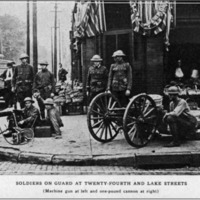Soldiers at 24th and Lake, Omaha, NE
Dublin Core
Title
Soldiers at 24th and Lake, Omaha, NE
Subject
Omaha Race Riot, 1919
Description
This photo shows soldiers posted at the corner of 24th and Lake in Omaha, a predominantly black neighborhood. The 1919 race riots in Omaha did not spark any kind of positive change in race relations; rather, covenants and other restrictive laws were tightened further in the aftermath of the riot.
The lynching of Will Brown came during a time of tension across America, as soldiers returning from World War I came home to find that, in the case of black soldiers, their lot had not changed much after fighting and dying for their country. The African-American population of Omaha doubled between 1910 and 1920, and white communities across the country (including Omaha) began to feel threatened by the growing African-American populations.
On September 25, 1919, as a result of the ongoing racial tensions and fear in the US, Will Brown was lynched in front of the burning Douglas County Courthouse after a a mob of angry white people attacked the police defending the courthouse, set the courthouse on fire and dragged Will Brown into the street where he was lynched and burned. Brown was accused by the mob of raping a white woman.
The lynching of Will Brown came during a time of tension across America, as soldiers returning from World War I came home to find that, in the case of black soldiers, their lot had not changed much after fighting and dying for their country. The African-American population of Omaha doubled between 1910 and 1920, and white communities across the country (including Omaha) began to feel threatened by the growing African-American populations.
On September 25, 1919, as a result of the ongoing racial tensions and fear in the US, Will Brown was lynched in front of the burning Douglas County Courthouse after a a mob of angry white people attacked the police defending the courthouse, set the courthouse on fire and dragged Will Brown into the street where he was lynched and burned. Brown was accused by the mob of raping a white woman.
Creator
Orville D. Menard
Source
Lest We Forget: The Lynching of Will Brown, Omaha's 1919 Race Riot
Publisher
Nebraska History
Date
1919
Citation
Orville D. Menard, “Soldiers at 24th and Lake, Omaha, NE,” History of Environmental Inequalities, accessed May 6, 2024, https://steppingintothemap.com/inequalities/items/show/63.
Embed
Copy the code below into your web page
